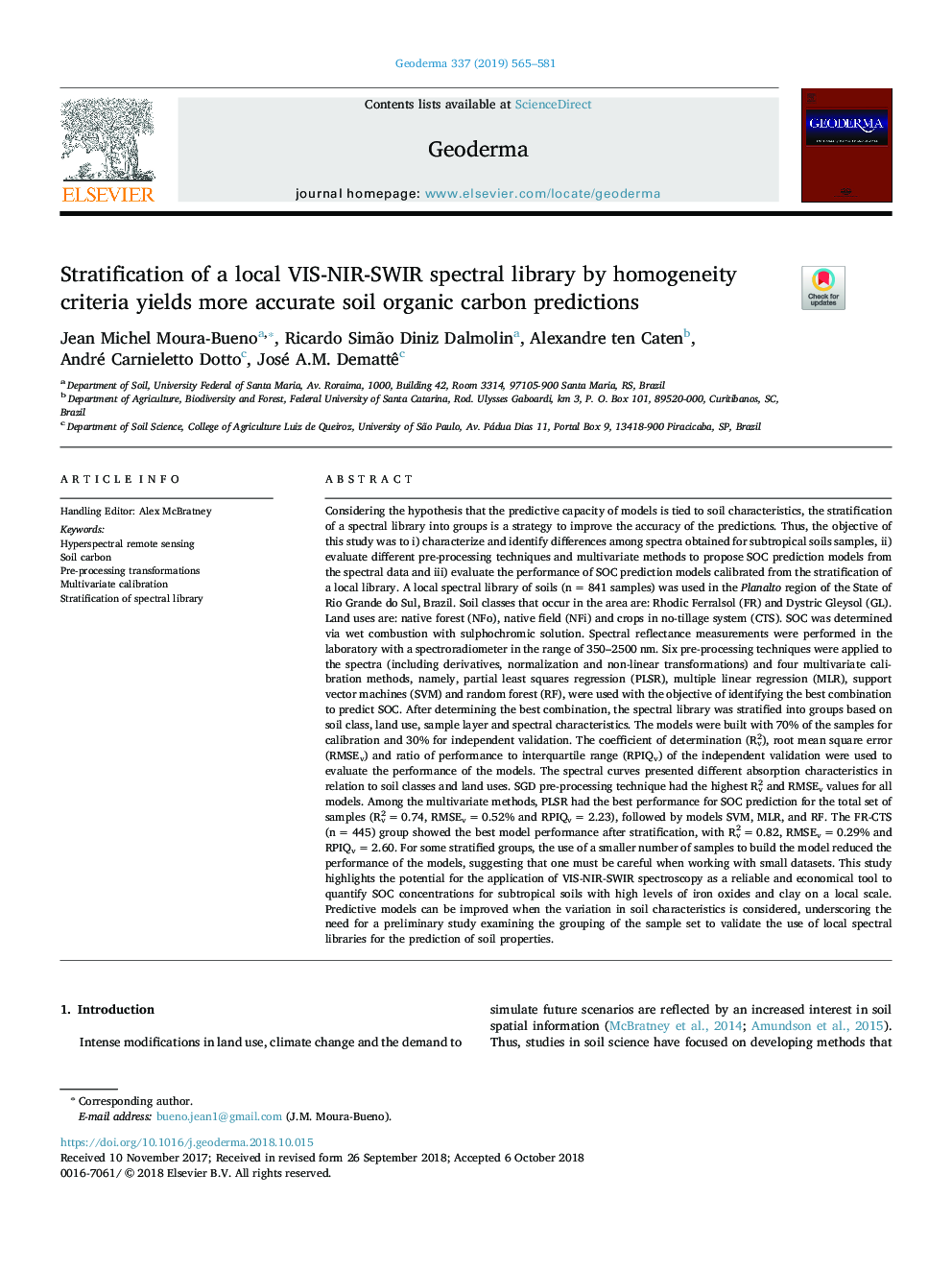| کد مقاله | کد نشریه | سال انتشار | مقاله انگلیسی | نسخه تمام متن |
|---|---|---|---|---|
| 11024809 | 1701069 | 2019 | 17 صفحه PDF | دانلود رایگان |
عنوان انگلیسی مقاله ISI
Stratification of a local VIS-NIR-SWIR spectral library by homogeneity criteria yields more accurate soil organic carbon predictions
دانلود مقاله + سفارش ترجمه
دانلود مقاله ISI انگلیسی
رایگان برای ایرانیان
کلمات کلیدی
موضوعات مرتبط
مهندسی و علوم پایه
علوم زمین و سیارات
فرآیندهای سطح زمین
پیش نمایش صفحه اول مقاله

چکیده انگلیسی
Considering the hypothesis that the predictive capacity of models is tied to soil characteristics, the stratification of a spectral library into groups is a strategy to improve the accuracy of the predictions. Thus, the objective of this study was to i) characterize and identify differences among spectra obtained for subtropical soils samples, ii) evaluate different pre-processing techniques and multivariate methods to propose SOC prediction models from the spectral data and iii) evaluate the performance of SOC prediction models calibrated from the stratification of a local library. A local spectral library of soils (nâ¯=â¯841 samples) was used in the Planalto region of the State of Rio Grande do Sul, Brazil. Soil classes that occur in the area are: Rhodic Ferralsol (FR) and Dystric Gleysol (GL). Land uses are: native forest (NFo), native field (NFi) and crops in no-tillage system (CTS). SOC was determined via wet combustion with sulphochromic solution. Spectral reflectance measurements were performed in the laboratory with a spectroradiometer in the range of 350-2500â¯nm. Six pre-processing techniques were applied to the spectra (including derivatives, normalization and non-linear transformations) and four multivariate calibration methods, namely, partial least squares regression (PLSR), multiple linear regression (MLR), support vector machines (SVM) and random forest (RF), were used with the objective of identifying the best combination to predict SOC. After determining the best combination, the spectral library was stratified into groups based on soil class, land use, sample layer and spectral characteristics. The models were built with 70% of the samples for calibration and 30% for independent validation. The coefficient of determination (R2v), root mean square error (RMSEv) and ratio of performance to interquartile range (RPIQv) of the independent validation were used to evaluate the performance of the models. The spectral curves presented different absorption characteristics in relation to soil classes and land uses. SGD pre-processing technique had the highest R2v and RMSEv values for all models. Among the multivariate methods, PLSR had the best performance for SOC prediction for the total set of samples (R2vâ¯=â¯0.74, RMSEvâ¯=â¯0.52% and RPIQvâ¯=â¯2.23), followed by models SVM, MLR, and RF. The FR-CTS (nâ¯=â¯445) group showed the best model performance after stratification, with R2vâ¯=â¯0.82, RMSEvâ¯=â¯0.29% and RPIQvâ¯=â¯2.60. For some stratified groups, the use of a smaller number of samples to build the model reduced the performance of the models, suggesting that one must be careful when working with small datasets. This study highlights the potential for the application of VIS-NIR-SWIR spectroscopy as a reliable and economical tool to quantify SOC concentrations for subtropical soils with high levels of iron oxides and clay on a local scale. Predictive models can be improved when the variation in soil characteristics is considered, underscoring the need for a preliminary study examining the grouping of the sample set to validate the use of local spectral libraries for the prediction of soil properties.
ناشر
Database: Elsevier - ScienceDirect (ساینس دایرکت)
Journal: Geoderma - Volume 337, 1 March 2019, Pages 565-581
Journal: Geoderma - Volume 337, 1 March 2019, Pages 565-581
نویسندگان
Jean Michel Moura-Bueno, Ricardo Simão Diniz Dalmolin, Alexandre ten Caten, André Carnieletto Dotto, José A.M. Demattê,